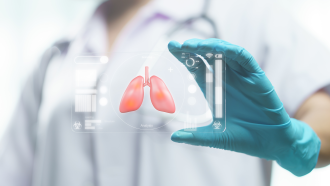Photo: Siddharth Kankaria / Research Matters
Drug resistance to Tuberculosis (TB) in India is an alarming public health problem, which is on the rise. Globally, India ranks second in terms of drug resistant TB with 1.3 lakh new cases detected in 2015 alone. Irregularities in the healthcare system such as wrong diagnosis, administration of sub-standard drugs, inadequate or irregular drug supply, lack of supervision, ignorance of healthcare workers and laboratory delays are largely blamed for the increase in drug resistance. However, there is little understanding of how the bacteria become drug resistant. In a recent study, scientists from the Indian Institute of Science, Bangalore, have decoded this complex process.
Mycobacterium tuberculosis (M. tuberculosis), the bacteria causing TB, is naturally resistant to some of the most common antibiotics such as penicillin, ampicillin or amoxicillin. It is known that when the bacteria are exposed to such antibiotics, it produces an enzyme called beta-lactamase, which breaks down these drugs, leading to the development of antibiotic resistance. However, drugs such as clavulanic acid that inhibit this enzyme, help in killing M. tuberculosis cells by the same drugs (penicillin/ampicillin/amoxicillin) to which it was earlier resistant. Based on this, M. tuberculosis can be killed by a combination of antibiotic drugs made up of amoxicillin and clavulanic acid, commonly marketed as Augmentin, which is widely used to treat different types of bacterial infection. While Augmentin can also kill M. tuberculosis, it is not yet clear how the drug exactly works, or how the bacteria might develop resistance to it.
The current study published in the journal eLIFE has developed a computer-based technique known as network analysis and experimental tools to understand how Augmentin works against TB bacteria. When exposed to Augmentin, M. tuberculosis develop ‘antibiotic’ stress and produces chemically reactive oxygen species. At normal levels, these reactive oxygen species are necessary for many normal physiological processes in the bacterial cells, but if its level gets too high, it can kill cells by damaging the DNA and other biomolecules
To understand the response of the bacterial cells to drugs that inhibit beta-lactamase, the researchers subjected M. tuberculosis cells to Augmentin. The experiments revealed that M tuberculosis could develop resistance to Augmentin by increasing the production of beta-lactamase that breaks down the antibiotic, and also by neutralizing reactive oxygen species with the help of mycothiol. “This is a first of its kind study where we have shown that the increase in both beta-lactamase and mycothiol together results in an increased resistance to the presence of antibiotics”, says Prof. Amit Singh, who led the study.
Treating with Augmentin also decreased the production WhiB4 – a bacterial protein that detects stressed cells and regulates the levels of both mycothiol and beta-lactamase. Due to the release of reactive oxygen species upon Augmentin treatment, the iron in the iron-sulphur cluster of WhiB4 gets damaged and results in changes to the expression of several additional proteins involved in bacterial cell membrane, carbohydrate metabolism, intracellular respiration and metabolic activities. All of these activities also contribute to keep the bacteria resistant towards drugs. Moreover, increasing the production of WhiB4 in M. tuberculosis makes it susceptible to Augmentin by decreasing the levels of active mycothiol and reducing the production of beta-lactamase.
The research is one of the first attempts in understanding the development of resistance to certain class of antibiotics. “These findings suggest that Augmentin could be more effective against drug-resistant tuberculosis and other bacterial infections if it is combined with a drug that can alter the levels of reactive oxygen species inside the bacterial cells”, remarks Prof. Singh. So what do the researchers plan for the future of this breakthrough study? “The next step is to search for new molecules that may be able to perform such a role”, says Dr. Saurabh Mishra, the lead author of the study.






